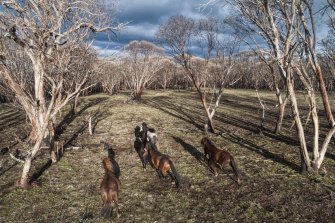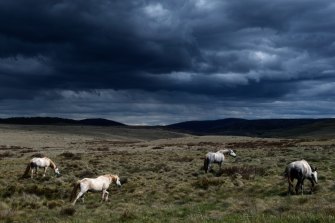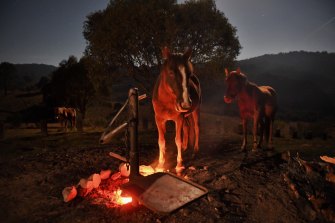
There was once a bloke who ran sheep in the Snowy Mountains high country named Jack Smith but everyone called him Sancho.
One day in 1942, a party of horsemen including then NSW premier William McKell and Sam Clayton, the state’s commissioner of soil conservation, encountered Sancho in the high country and heard his story.
Clayton later wrote in his journal: “He was left in charge of sheep in the mountains at the age of nine for five weeks by himself after his father was taken to Cooma with appendicitis. Now he is a battler in the mountains for grass — I hesitate to be hard on a man like this.”
But Clayton was hard. He was among a group of scientists and naturalists who believed that grazing in the Australian alps had wreaked havoc on the delicate ecosystem across NSW and Victoria, and he was there to convince McKell to force the graziers out.

Running wild: feral horses on Long Plain in the Kosciusko National Park.Credit:Nick Moir
There was tension in the party during the expedition. A grazier named Charley Harnett furiously opposed the scientists there and Clayton wrote at one point: “It was a miracle he didn’t shoot me or I drown him in one of the river crossings.”
In any event, Clayton convinced McKell that the region’s watercourses had been wrecked by the trampling of cloven hooves, and that the fires the graziers lit to generate the green shoots their animals preferred had dried out the mosses that fed the rivers during summer. A few years later, the government acted and grazing leases were wound up, sparking what became known as the Range Wars between rogue graziers who flouted the new laws and drove their herds into the high country during the summer months and the rangers and soil conservation officers sent in to police them.
Communities were divided and bloodshed was not entirely uncommon.
In 1959, according to a history of the NSW Soil Conservation Service by Roland Breckwoldt called The Dirt Doctors, a ranger called C.H. Harvey tried to impound a mob of sheep in the Snowys when the owner and his brother rode up.
“He kept on repeating, ‘You stinking old bastard. You’ve lived on sheep all your life and now you’re doing this. You ought to leave this stinking bloody job.’ All the time he was saying this he kept riding around me. He had a big stick in his hand which was about four feet long and two inches thick. He kept on poking this stick at me every time he spoke ... He was a big man and I was really afraid he was going to hit me. I’ve never seen a man as angry as Archie Turner.”
Back then, the graziers had little time for the feral horses that competed with their herds for feed and wrecked their fences. The Herald reported that in the 1940s, some had called on the government to let them use machine guns to exterminate them.
Today, the sheep and cattle are long gone, but there are more horses than ever. According to surveys relied upon by both state governments and endorsed by the CSIRO, numbers in the Australian alps leapt from 9187 in 2014 to 25,318 in 2019 and are now growing at a rate of 23 per cent a year.
The Victorian government and the NSW Environment Minister, Matt Kean, are determined to reduce their number, but many defend the horses as emblematic of the old high country culture.
The dispute sprawls from the outskirts of Canberra into the Victorian alps, from NSW Parliament House to federal courtrooms in Victoria.
Target of attacks
Richard Swain spent much of his childhood in the high country where his father was one of the dirt doctors sent in to repair the damage done by the grazing. Today, he works as a guide on the Snowy River and serves as Indigenous ambassador for the Invasive Species Council. The horses, he says, are wreaking havoc.
Swain says he was moved to join the campaign for their removal when he saw that others were falling silent because of anger vented against them.
He became involved just as the NSW government appeared to have come to an agreement on how to best reduce numbers on the NSW side of the border, an agreement that was torpedoed at the last moment by the leader of the NSW National Party, John Barilaro.

Indigenous Snowy Mountains guide Richard Swain has faced racist abuse and harassment for his stance on feral horses. Swain is pictured on Long Plain where he says trampling by horses has damaged the creeks and threatened the habitat of the native Broad-Tooth Rat.Credit:Nick Moir
Barilaro, who represents the state seat of Monaro, shocked some of his Liberal Party colleagues when he introduced the so-called brumby bill before the last state election in 2019. It sidelined scientific advice about the damage the horses were doing and underscored the heritage value of the animals. The move prompted despair among those who had spent years negotiating a culling plan. It prompted Professor David Watson, an ecologist at Charles Sturt University, to resign from the NSW Threatened Species Scientific Committee which had provided advice to the government on the impact of the horses, but it helped secure an unlikely swing to Barilaro.
Swain says Barilaro’s campaign spurred the vitriol against his family. At first, the attacks were online and often targeted his business, but the abuse bled into the real world. Photos of his company vehicles were shared on brumby Facebook pages and they were then vandalised. Twice, human excrement was left in his driveway, he says. On February 19 last year, he was at a market in Cooma gathering signatures for a petition against Barilaro’s bill. He says his mother was abused and teenage daughter challenged to a fight.
In parliament in August, Barilaro called Swain's petition anti-democratic and accused him of being part of an “inner-city Sydney group” that lived in a “fantasy". Barilaro did not respond to a request for comment.
It wasn’t just Swain who was copping abuse. Watson, too, found that whenever he spoke out, he would receive personal and professional attacks by email and phone; the most recent incident was on Thursday.
Also on Thursday night, Deakin University ecologist Professor Don Driscoll had been invited to address a webinar on the brumbies to be hosted by the Bond Street Event Centre in Sale in south-west Victoria. Due to the tone and scale of online chatter, the centre cancelled the event.
“Anybody living close to Sale?” said one message on the Facebook page Rural Resistance. “A little protest outside would be helpful ... someone that’s on our side should join this meeting.''
Many others chimed in. In the end, the event was hosted by Deakin University.
Like Swain, Driscoll believes much of the animosity is born of generations-old resentment over the removal of the cattle. Perhaps, he says, they believe that if the horses wreck the environment enough, there will be no reason not to let the cattle return.
Rural Resistance was established by Phil Maguire to challenge what he sees as unfair attacks by city people on the culture of high country people in Victoria. Maguire, who owns a property adjoining the Bogong High Plains in Victoria, recently led and lost a court case seeking to prevent the Victorian cull.
In Maguire’s view, the mountain horses “deserve more respect” than other pest species, such as deer, pigs and goats, because they helped build Australia and “fought with us at Beersheba”, a reference to the World War I Light Horse charge.

A mob of brumbies near Kiandra in the high plains of the Kosciuszko National Park.Credit:Nick Moir
He says he still plans to appeal the failed case against the Victorian cull, and claims that he has been abused by other brumby supporters, who he believes are jealous of the donations he has solicited via the Rural Resistance page to support the cause. He denies the suggestion advanced by many people contacted by the Herald and The Age that Rural Resistance spurred the dark tone of the debate.
Rather, he says, women might be the problem.
“There are a lot of women who are involved [in the pro-brumby cause] and they seem to be causing the angst. Maybe it is a female horse thing.” Maguire’s wife, Louise, agrees. “I think there are a bunch of middle-aged women who have nothing better to do than go nutty over brumbies.”
'It's a bloody invasion'
Back across the border, another staunch brumby supporter is former state Nationals MP Peter Cochran, a proud supporter of — and donor to — Barilaro.
Cochran runs a business guiding tourists to the brumbies on horseback, but dismisses the suggestion that this presents a conflict of interest because, as he puts it, “I make sweet f--- all out of it”.
Cochran says he fights for the brumbies and those who love them because they are a dispossessed people.
“We have been pitched out of our land,” he says. “It’s a bloody invasion is what it is.”
Cochran argues that mountain people across the world — from the Montagnards of Vietnam where he fought as a young soldier, to the Tibetans and the Appalachians of the US — have always had a distinctive culture and always been mistreated.
“These were the people who blazed their way into the bush in bloody tough times and lived here in terrible conditions,” he says of his high country ancestors.

Brumbies warm themselves by a campfire at Blue Waterholes in the northern Kosciuszko National Park. Credit:Nick Moir
He dismisses Swain’s views, saying that as a Wiradjuri man, Swain has no traditional connection with the land.
Cochran rejects the estimates of horse numbers offered by scientists, their view of the damage caused by the horses and their predictions of the herd’s reproduction rate.
“Everyone says listen to the scientists, listen to the scientists. Well, f--- the scientists. You have to listen to the wisdom of the people.”
Whatever you make of Cochran’s stance, he is at least consistent. In The Dirt Doctors, he is quoted as saying during a public meeting in 1973: “To those of you who have been falsely led by the preachings and propaganda of ill-advised, inexperienced, dictatorial bureaucrats … we true conservationists will not tolerate the desecration of this park which was the birthplace of the men from Snowy River. We have been pitched out of our land bit by bit and now is the time to halt this cancerous spread.”
Swain is equally passionate.
“When I was a boy, Cooma had the sweetest water in the country. Not any more. The water is disgusting now. The horses track along the bogs and fens and sponges, they wreck it all.”
Swain says he can spend days paddling the most remote sections of the Snowy River and see only a handful of platypuses and a couple of emus, but hundreds of horses.
“It’s heartbreaking. It is a desecration.”






 Add Category
Add Category